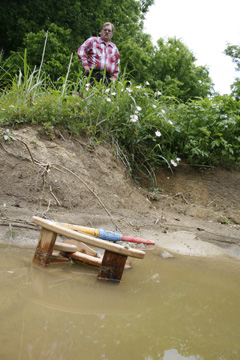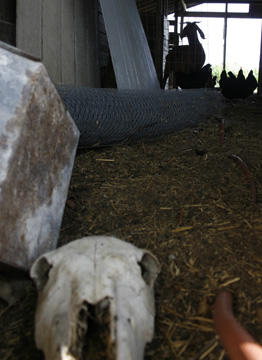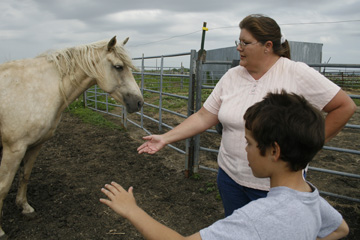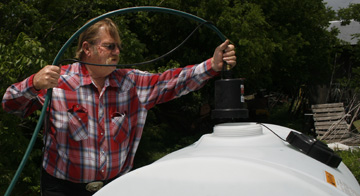 Sayers: A hydrologist “told me not to use [the water] for anything ... not even for watering the grass.”
Sayers: A hydrologist “told me not to use [the water] for anything ... not even for watering the grass.”
|
 After several of the Beadles’ goats died, they sold the rest.
After several of the Beadles’ goats died, they sold the rest.
|
 Charlotte Harris, with grandson Devon: The water came back on “like Old Faithful ... and wouldn’t stop.”
Charlotte Harris, with grandson Devon: The water came back on “like Old Faithful ... and wouldn’t stop.”
|
 Sayers makes three trips a week to get water for his family.
Sayers makes three trips a week to get water for his family.
|
|
A D V E R T I S E M E N T
|
|
|
|
A D V E R T I S E M E N T
|
|
Water Foul
An aquifer is at risk – along with property values, livestock, and dreams – after gas wells move in.
By PETER GORMAN photos by Jimmy Alford
Brian Beadle knew something was wrong when the registered Boer goats he raises on his small farm near Grandview began swelling up just after Christmas. But when three of his goats and two kids — and a llama — died within the next few days, the 44-year-old contractor knew he had a major problem on his hands.
He did. His well had just gone bad. Very bad: Its water proved to be loaded with sulfates and a naturally occurring hydrocarbon called toluene, a gasoline additive and solvent that is toxic for humans and animals, causing problems from nausea to deafness, blindness, and, at high enough dosages, death.
Within the next two weeks, Beadle learned that at least two of the other small-acreage landowners near him, in Hill County just south of the Johnson County line, were having similar, extremely serious problems with their wells. All their wells, which had produced clean, healthy water for years, were drilled into the Trinity Woodbine aquifer, which underlies much of North Texas.
The neighbors shared another characteristic: All their properties were within a couple of hundred yards of two gas wells recently drilled by Williams Production-Gulf Coast Co. — one producing, the other abandoned and plugged after a drill bit was lost during the “fraccing” process.
Gas drilling in North Texas’ Barnett Shale range has been a worry for years, especially for homeowners, ranchers, and farmers who depend on well water. Fraccing involves forcing high-pressure water and chemicals into an underground rock formation to fracture it and free up the gas trapped within it. When the drilling starts, residents in many cases have found their water wells going dry, some temporarily, some permanently. In other places, the wells have come up full of mud, the water brown, sudsy, and foul-smelling.
But the deeper fear has been of what would happen if drilling somehow contaminated the aquifers, the underground rivers that the entire region depends on. Until now, the gas companies have pooh-poohed the fear, claiming their wells are dug at much deeper levels than the Trinity-Woodbine aquifer, which provides commercial, industrial, and livestock water for much of the Metroplex. But the nightmare has become a reality for Beadle and his neighbors: They have no water. And in rural Texas, if you don’t have water, you’ve got nothin’.
The presence of toluene in the water was a red flag that something was terribly wrong underground. And in the four months since the first tests were done on water from his well, levels of the deadly chemical haven’t dropped — meaning, hydrologists say, that the solvent, which never occurs naturally in fresh water, is continuing to enter the aquifer.
“Now I was raising goats, and I never lost one before, and then I lost five, all at once,” said Beadle. “So I had to sell the other 34. I couldn’t take a chance on that kind of money being lost. I took one heck of a hit.”
The drilling company, which provided tanks and free water while it did its own analysis, now denies any connection between the water problems and the gas wells. When they were finished drilling, they cut off the residents’ water supply, collected the tanks, and shut down the drill site. The Texas Railroad Commission is looking into the matter — but that agency, which regulates the oil and gas industry, has to this point accepted no responsibility for water-related questions, leading to a round of bureaucratic finger-pointing among state agencies.
So now Beadle and his wife are looking for a house to rent. One neighbor couple may have to sell their horses. The families’ dreams of life in the country are fractured, maybe beyond repair. As a third neighbor said, “My house, everything I have is worthless right now.”
Across a short stretch of prairie from Beadle’s house, Charlotte Harris was standing in her kitchen doing dishes one day when suddenly she had no water. It was two or three days after the second of the two Williams wells was fracced. “I said ‘Good grief! What happened to the well?’ I mean it just stopped.” When the water came back on several hours later, it caused more problems. “When I went to flush the toilet, that water came back on and came out of that thing like Old Faithful. It just streamed out there and wouldn’t stop. It wound up ruining my bathroom floors. My husband finally came home from work and turned down the pressure.”
Stevan Harris found that, when the water pressure came back on, “It was so strong it blew out the pipes under my sink. And then a couple of days after that it started smelling real bad. You know, like boiled eggs or human gas. I thought something must be wrong with my hot water tank — that smelled worse than the cold water — and so I went out and bought a new one, but that didn’t make any difference.”
John Sayers owns 17 acres adjacent to the Harris’ place. When the pressure in his water lines dropped, Sayers said, it stayed off long enough to burn out his well pump. Only later, when the ground around his well turned into mud, did he realize that when water pressure came barreling back, it had blown out the 4-inch pipe that connected the well to his house. “It just blew that pipe joint to pieces, and that was buried five feet underground,” he said.
Neither the new water heater nor the new pump fixed the problem. At all three neighbors’ houses, the well water was useless and smelled strongly of sulfur. Taking a shower left a person itching all over.
Sayers, 55, took a sample of the smelly water to a hydrologist in Alvarado. “He ran some tests for me the Friday before New Year’s,” Sayers said. “And he told me not to use it for anything — not for showering, cooking, feeding animals, not even for watering the grass.” Sayers called Williams, but, with the holiday, got no answers. “When no one called me back, I called those numbers again and said that I was either going to hear from someone or the next calls I made were going to be to the Railroad Commission. And suddenly everyone at Williams called me back.”
Sayers’ son and daughter both have houses on his property, which he’s owned since 1983. His son arranged for three tanks to be brought out to the property. The drilling company paid for those tanks and for tanks for the Beadles and the Harrises as well. Williams also sent a geologist out to take water samples. It looked as though the gas company was going to do the right thing.
“And then in early March, two months into the problem,” Sayers said, “I got a registered letter from Robert Gibson, district manager of exploration and production of Williams’ Gulf Coast Co., that basically said, ‘Sorry, fellas, you’re on your own.’ ”
Gibson wrote that tests had shown nothing wrong with Sayers’ well. The company “expended substantial resources investigating your allegations” but eventually determined that “the issues you allege are not caused by the activities of WPC.”
A week and a half later, on March 17, Williams ended the water delivery to all three properties and picked up tanks from all but the Beadles.
“They probably thought that would be the end of it,” said Tony Maturo, a consultant hired by Sayers. “But they don’t know John Sayers. He’s a bulldog. He’s a pain in the ass. And he’s not going away.”
Maturo works for BCR Consultants, which does oil and gas work for landowners, from negotiating leases to investigating a problem like Sayers’.
Maturo looked first at the sample taken by the geologist for Williams. “That test was simply not done properly. The water was put into a plastic jug, not glass, which is a no-no. Then, it was never put on ice, there is no chain of custody for that sample, and it wasn’t tested to the levels it should have been. So Sayers had his own testing done.”
That test, by Talem Inc., of Fort Worth, showed elevated levels of sulphates and the presence of toluene in Sayers’ well. “That test was done properly,” said Maturo.
“And the only thing that has changed in the last 25 years has been the two wells drilled by Williams,” he said. “Williams can claim they’re not responsible all they want, but something happened that affected that water supply. Something dropped hydrocarbons in there, and it’s not just Sayers’ well. There are three wells affected.”
Like the Beadles, Stevan and Charlotte Harris have a simple home on 14 acres. They’re raising their 8-year-old grandson, Devon. Their hilltop place, looking down over a lush valley, is a wonderful menagerie, with cats, dogs, chickens, and seven horses. Three mares have colts only a few weeks old; their stallion is a registered Tennessee Walking Horse.
“I bought this land about 10 years ago,” Harris said recently. “I saved up a long time to do it, and it’s the only property I’m ever going to have. I was thinking that I was going to plant 50 pecan trees along the front and side so that when I retire I could sit out there and maybe sell pecans. Now? I don’t know. With the water bad, they might not grow or might not produce pecans you could eat.”
Harris bought a 1,500-gallon tank and fills it from a smaller trailer-mounted tank that attaches to his pickup truck. At first he got water from another neighbor’s well but now fills up at work and pays the difference in the water bill there.
His whole life now revolves around getting water, Harris said. “It’s not just water to wash dishes or cook with or even shower with or use in the toilet. Those things are bad enough. But I’ve got the horses, and I’ve either got to be able to haul water for them or get rid of them.”
Last year he bought a good above-ground pool for Devon, but Harris said he can’t imagine hauling enough water to fill it this summer.
Fortunately, Harris isn’t dependent on the land to make his living yet. His day job is, ironically, building heavy machinery like that used to drill gas wells. But he usually makes a few thousand dollars a year from sales of the colts; if he can’t afford to keep this year’s colts until they’re weaned, he may lose $2,000 to $3,000.
The Beadles have been hit harder. Their goats sell for between $600 and $800, and considering those that died and others sold at half-price or less, he’s probably lost $10,000 to $15,000. “That’s about one-third of my annual income right there. And it’s going to be one-third of my income next year too, if nobody takes responsibility and cleans up this mess they made.”
Sayers, who owns two frame and gift shops, is probably the most financially secure of the three. But he, too, has been hit by the loss of usable well water: It cost him the potential profit from 5,000 Christmas trees he’d hoped to get started in his greenhouse. “I was just about ready to start those saplings in there when this happened,” he said.
Couldn’t he even use the bad water on plants?
“I’ve been told not to,” he said. “You know those old cowboy movies where you see the water hole and all the bones of animals around it, animals that died because they drank the poisoned water? Well, that’s what I’m told those trees would look like if I used this water on them.”
Fire is another aspect of the water situation that has the neighbors worried. When a lightning storm sparked a blaze in a fourth neighbor’s pasture recently, Harris said he prayed it would not cross the road onto his land. “I don’t even know if I could use the bad water for that because the toluene might just make the fire worse,” he said. But even if he could, by the time he switched hoses back to the well, he said, “My house would already be burned.”
The Beadles can’t afford to haul water in, so Chrystal Beadle has to go to her mother’s house in Benbrook each day to do her insurance work.
“We’re going to have to go rent a house somewhere,” Brian Beadle said. “We can’t stay here, and she can’t be at her mother’s all the time.”
––––––––––––––––––––––
When gas companies insist that their drilling activities don’t affect water wells, it seems a reasonable enough assertion – water wells are usually drilled to depths from 125 to 300 feet, while gas in the Barnett Shale is usually found at 8,000 feet or deeper.
But that’s the theory, not always the practice. And Beadle thinks he knows what might have happened to the gas wells 20 yards from his back fence.
When his animals started dying just after the second gas well was being fracced, Beadle said, he walked over and asked one of the Williams workers what part of the drilling process might be affecting his water well.
“He said they — Williams — thought they blew out the [gas] well at about 700 feet. He said they sent him out here to consider concreting up the well to fix the problem,” Beadle recounted. That could mean that the blowout had left a leak in the piping that brings the natural gas up to the surface.
“It all started just when they were fraccing that well,” Beadle said. “And now, of course, Williams says it’s not their responsibility and that they had nothing to do with it.”
Sayers has been the mover of the trio. He’s called the Railroad Commission, hired consultants, and says he is ready to fight as long as it takes to get Williams to clean up a mess he clearly sees as their making. “Look, the samples show we have toluene in the water. That’s a hydrocarbon used as a paint-stripper and in the making of explosives. Now I’ve lived here since 1985, and we always had the best water in the neighborhood.
“We’ve also got an elevated ion count — a high electrical charge caused by excess salt in the water — and an elevated sulfur count. It’s just not usable water. And worse, in my case it’s not just me but my son and daughter also have houses on this property. And with their kids, well, we’ve got 10 people depending on this water, and now we don’t have it.”
Connecting to Grandview’s city water supply, more than two miles away, would cost hundreds of thousands of dollars, money the families don’t have.
“My house, everything I have is worthless right now because I’ve got no water source,” Sayers said.
Like Harris, he now hauls his own water, bringing in about 1,000 gallons a week from his store in Burleson. He called the company that drilled his first well and asked if they thought drilling a new water well nearly 2,500 feet from the Williams site might help. “They told me I was rolling dice,” he said. “They said that even if the water was good at first, if hydrocarbons are being released into the aquifer, it would only be a matter of time before they spread through and poisoned the whole darned thing.”
––––––––––––––––––––––
Results from a mid-April test done by the Railroad Commission haven’t come in yet. But two tests done by consultants for Sayers show the problem, he said.
The first test, by Talem, showed the elevated ions, sulphates, and presence of toluene. If, as Sayers and the others were hoping, the toluene somehow had gotten into the water from a ground source that was disturbed, like some old paint-thinner cans hidden deep in the earth, the second test, several weeks later, should have showed the levels dropping off significantly. They weren’t. Instead, the second test showed that the hydrocarbon level was stable, indicating that more hydrocarbons were entering the Woodbine aquifer.
The latest test on Sayers’ well was performed by Cirrus Associates, LLC, an environmental and hydrogeologic consulting firm. Dr. Judy Reaves, a hydrogeologist with almost 20 years’ experience, said the level of toluene “doesn’t exceed the Environmental Protection Agency’s level of risk. Still, I’m concerned because it didn’t just get there by itself.” She also said the strong sulfur odor is unusual and a concern.
“The presence of toluene in the water, regardless of the level, is potentially dangerous,” she said. “It’s there in the water, it’s a poison, and it is not naturally occurring in water.
“If you press me to say the oil drilling is directly responsible, that’s not something I do. But I can say that oil and gas companies are in the business of producing hydrocarbons. And if they’re found in the water where drilling is going on or has gone on, that would make it suspect.”
Richard S. Record, a geologist and Cirrus’ Dallas operations manager, also noted that toluene in the sample from Sayers’ well falls below the level that the EPA labels as unsafe. “Realistically, though, that only means that they’re below the range where one in 10,000 would have a serious or life-threatening problem,” he said. “So it’s a model. And if it were me, or more importantly, say my pregnant daughter or wife, regardless of what the EPA says, I would not allow them to drink that water.”
He said traces of hydrocarbons are sometimes found in swampy waters, but absolutely never in an aquifer, “particularly something like toluene.
“Sayers thinks, and he may not be wrong, that when the drilling was done, something got stirred up down there—both the sulfates and the hydrocarbons,” Record said. If the source is still “stirred up,” he said, “well, it might take a very long time ... for that to clear out.”
And, he said, it’s possible for water wells closest to the source of a pollutant to be ruined while wells a few miles away are unaffected. “It might be diluted enough by the time it gets downstream to not affect the next guy,” he said.
Williams is sticking with its story that their drilling had no impact on the water.
“In December, they came to us with some potential concerns about water quality,” media relations representative Kelly Swan wrote in a letter to Fort Worth Weekly. “Since we had worked in the area, we took what they said to heart and acted immediately — providing them with an alternate source of water, hiring an independent environmental consulting firm to take water samples from their wells, and hiring an independent hydrogeologist to study groundwater characteristics (depth, flow rate, direction, quality, etc). ... In the end, the results of the investigation did not indicate a connection or link with our drilling/completion activities or the materials used in our operations.”
Maturo thinks that approach is a big mistake. “When I talked with Williams, I suggested it would be better for them to simply clean up this problem rather than hope Sayers is going to disappear. Because he won’t. And their response was ‘Well, we’re ready for that.’ Ready for that? Ready for what? This might just have been a one-in-a-million situation, but it still exists. And it sure looks like the big gas company is running all over the little guy here.”
If Williams won’t somehow remedy the problem, Sayers said, he and the others will sue. “You can’t just come and make our properties and our lives worthless,” he said. “We’ve all worked for this land.”
Of course, winning lawsuits against big companies is always difficult. “But we’ve got to try it,” said Harris. “Even if we don’t win, maybe we’ll shine just enough light on this to keep it from happening to someone else.
“When I was a kid, we lived in Connecticut,” he said. “And we had this well that was fed by this underground spring. And then some company came and dug out a hillside and exposed that spring, and it ... caused our well to run dry. And so for the next two years or so until we finally moved, I had to go and get water and carry it on my bicycle to the house. Now here it is, 45 years later, and I’m back to hauling water.”
“The whole thing just stinks,” said Harris. “My house is worthless, I might have to sell the horses, and then I still don’t know what the heck I’m supposed to do about my grandson’s swimming pool.”
You can reach Peter Gorman at
peterg9@yahoo.com.
 Email this Article...
Email this Article...

